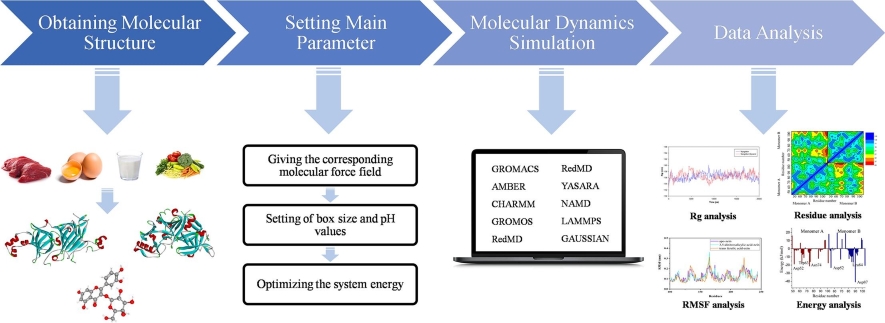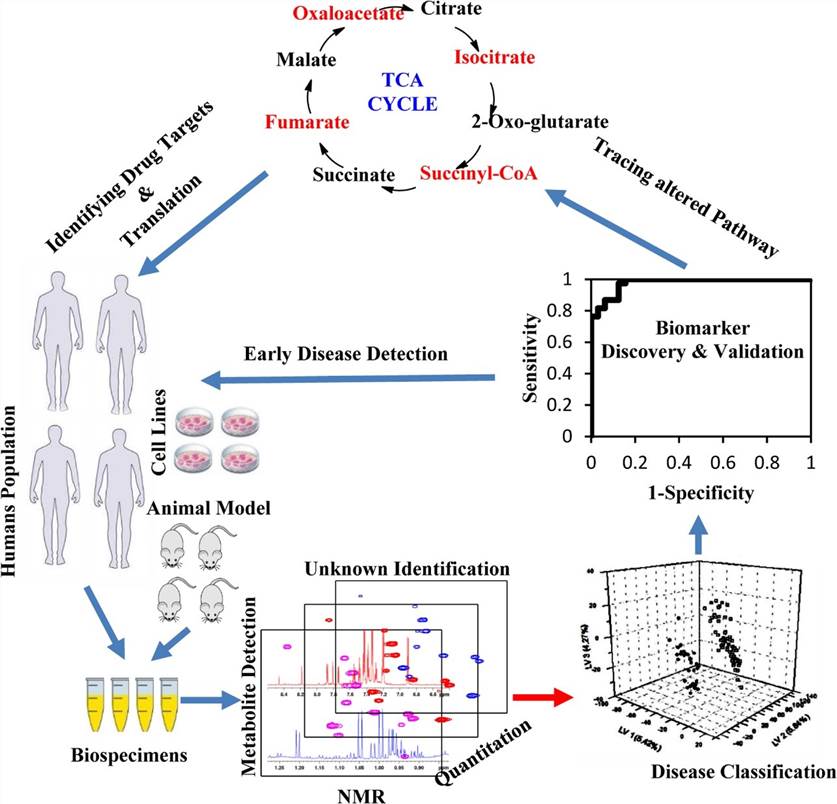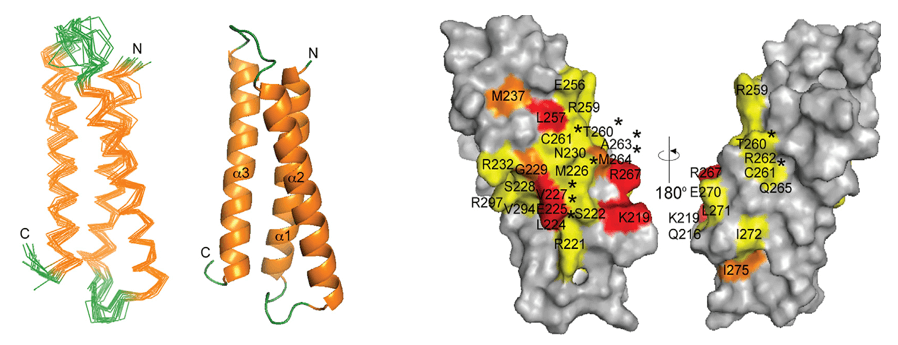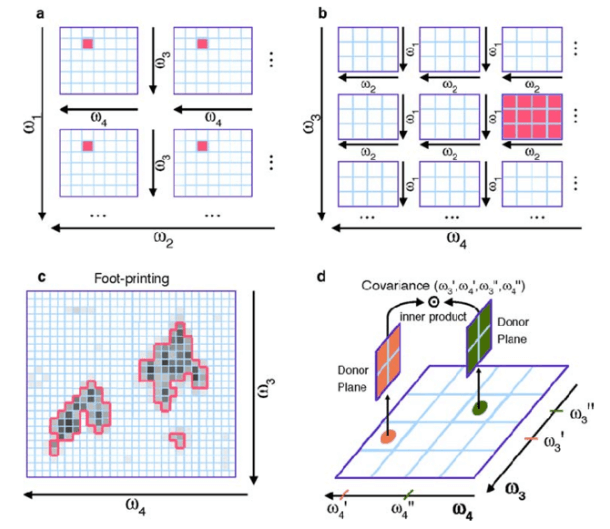Nuclear Magnetic Resonance (NMR) spectroscopy has long been a cornerstone of analytical chemistry, structural biology, and materials science, providing insight into the molecular composition, dynamics, and interactions of a wide range of materials. Over the past few decades, NMR technology has advanced significantly, with high-throughput (HT) capabilities becoming a focal point in many research areas. In particular, the advent of high-throughput NMR spectroscopy has revolutionized several fields by enabling the efficient and automated analysis of large sample sets in a fraction of the time previously required.
At Creative Biostructure, we harness the power of NMR spectroscopy to support high-throughput research across diverse scientific and industrial fields.
 Figure 1. An overview schematic of the main components of the new high throughput NMR experimental setup. a. A series of plugs of different samples separated by an immiscible fluid are hydraulically transported in a flow tube (OD/ID, 1.6/1 mm, Teflon) through a custom-built NMR probe mounted in an 11.7 T NMR magnet. The flow is controlled from outside the magnet using a standard syringe pump. A microcontroller is used to drive capacitive sensors on the probe head to sense the position and the velocity of the samples and synchronize the NMR acquisition. b. Photograph of a custom-built probe head mounted on the NMR probe. The probe head has a PCB that possesses a micro-NMR detector with pre-tuning and matching network, two capacitive sensors with their interface electronics, and a glass capillary through which the sample flow tube is fed. A 3D printed holder supports the PCB. Right: a microscopic image for the NMR detector, the capacitive sensor, and the insertions of the PTFE tube inside the glass capillary. Left: schematic of the equivalent electrical circuit in the NMR probe. (Nassar et al., 2021)
Figure 1. An overview schematic of the main components of the new high throughput NMR experimental setup. a. A series of plugs of different samples separated by an immiscible fluid are hydraulically transported in a flow tube (OD/ID, 1.6/1 mm, Teflon) through a custom-built NMR probe mounted in an 11.7 T NMR magnet. The flow is controlled from outside the magnet using a standard syringe pump. A microcontroller is used to drive capacitive sensors on the probe head to sense the position and the velocity of the samples and synchronize the NMR acquisition. b. Photograph of a custom-built probe head mounted on the NMR probe. The probe head has a PCB that possesses a micro-NMR detector with pre-tuning and matching network, two capacitive sensors with their interface electronics, and a glass capillary through which the sample flow tube is fed. A 3D printed holder supports the PCB. Right: a microscopic image for the NMR detector, the capacitive sensor, and the insertions of the PTFE tube inside the glass capillary. Left: schematic of the equivalent electrical circuit in the NMR probe. (Nassar et al., 2021)
Introduction to NMR Spectroscopy
Principles of NMR Spectroscopy
NMR spectroscopy uses the magnetic properties of atomic nuclei. When a sample is placed in a strong magnetic field, certain atomic nuclei, most commonly hydrogen and carbon, resonate at a characteristic frequency. This frequency depends on the local environment of the nucleus, including factors such as neighboring atoms, chemical bonds, and molecular motion. By measuring the resonance frequency and the interaction between nuclei, NMR can provide a wealth of structural, dynamic, and functional information about molecules.
 Figure 2. The principle of NMR. (a) The net magnetic moment in the presence of B0 aligns with it. (b) The magnetization of the nuclei can be tipped away from the z-direction by applying a B1 in the y-direction. (c) After the excitation, the magnetization of the nuclei, which bears information of the samples, can be recorded and analyzed. It should be noted that for (b) and (c), there is a B0 in the background. (Fan et al., 2022)
Figure 2. The principle of NMR. (a) The net magnetic moment in the presence of B0 aligns with it. (b) The magnetization of the nuclei can be tipped away from the z-direction by applying a B1 in the y-direction. (c) After the excitation, the magnetization of the nuclei, which bears information of the samples, can be recorded and analyzed. It should be noted that for (b) and (c), there is a B0 in the background. (Fan et al., 2022)
Simply put, NMR can reveal the chemical structure of compounds, elucidate conformational dynamics, and even monitor biomolecular interactions in solution. The power of NMR lies in its ability to capture these details without the need to crystallize the sample, unlike X-ray diffraction techniques, making it highly versatile in many applications.
Types of NMR Techniques
There are several NMR techniques used depending on the research question. The most commonly used are:
- 1D NMR: Provides basic chemical shift information, useful for identifying molecular structures.
- 2D NMR: Expands on 1D NMR by measuring interactions between nuclei, helping to elucidate molecular connectivity.
- 3D/4D NMR: Allows for even more complex analyses, particularly in structural biology for the study of large biomolecules.
- Solid-State NMR: Used to analyze non-soluble samples, such as proteins in membranes or crystalline solids.
High-Throughput NMR
High-throughput NMR (HT-NMR) refers to the application of NMR spectroscopy in an automated, parallelized fashion, allowing the analysis of large numbers of samples quickly and efficiently. HT-NMR has become increasingly important due to its ability to process large amounts of data in a short period of time, facilitating drug discovery, metabolomics, and various other research applications.
Technological Advancements in High-Throughput NMR
The development of high-throughput NMR spectrometers has been driven by several technological advances. These advances can be grouped into hardware improvements, automation, and software innovations, each of which plays a critical role in making NMR a viable tool for large-scale research.
Automated Sample Handling and High-Throughput Systems
Automation is perhaps the most important driver of high-throughput NMR. Traditionally, NMR sample preparation has been labor-intensive and time-consuming, requiring manual sample handling, insertion, and measurement. However, recent advances have led to the development of fully automated sample changers and robotic systems capable of handling hundreds or even thousands of samples in a single run.
Modern automated sample handling systems are designed to:
- Minimize human error by standardizing sample preparation.
- Maximize throughput by running multiple samples consecutively without manual intervention.
- Integrate with high-capacity NMR instruments capable of maintaining data quality over long hours of automated operation.
These systems typically include robotic arms or liquid handling platforms that transfer samples into NMR tubes, place them in the spectrometer, and perform all the steps necessary for measurement. Some platforms also provide temperature-controlled environments to maintain sample consistency.
 Figure 3. NMR spectrometer with autosampler.
Figure 3. NMR spectrometer with autosampler.
High-Field NMR Instruments
The resolution and sensitivity of NMR depend significantly on the strength of the magnetic field, measured in Tesla (T). In high-throughput research, the use of high-field NMR magnets, ranging from 500 MHz to 1.2 GHz, has greatly improved the quality of data. High-field NMR spectrometers provide superior signal-to-noise ratios, allowing researchers to obtain high-quality data even from dilute or small-volume samples.
The increased sensitivity and resolution of these instruments are particularly valuable when working with complex mixtures or biofluids, where the signals from various components need to be clearly separated.
Multiplexing and Parallelization
Multiplexing involves performing multiple NMR measurements simultaneously or in parallel. In high-throughput systems, this is often achieved by using multi-dimensional NMR techniques (such as 2D or 3D NMR) in combination with advanced probe designs that allow simultaneous measurement of multiple samples. This significantly reduces the time spent on each sample and increases throughput.
Parallelization can also be achieved by using multi-probe setups that allow simultaneous acquisition of data from multiple samples. Some advanced setups utilize high-density sample racks, allowing dozens or even hundreds of samples to be analyzed in a single run.
 Figure 4. Approach to multiple microcoil NMR using radiofrequency coils connected in parallel. In this configuration, data from multiple samples are acquired in a single experiment using a spatially selective pulse—a frequency-selective pulse applied simultaneously with a magnetic field gradient in the z direction—akin to slice selection in magnetic resonance imaging (MRI). (Kupče et al., 2021)
Figure 4. Approach to multiple microcoil NMR using radiofrequency coils connected in parallel. In this configuration, data from multiple samples are acquired in a single experiment using a spatially selective pulse—a frequency-selective pulse applied simultaneously with a magnetic field gradient in the z direction—akin to slice selection in magnetic resonance imaging (MRI). (Kupče et al., 2021)
Increased Sensitivity and Advanced Detection Techniques
NMR sensitivity is critical when working with small or dilute samples, which is often the case in high-throughput workflows. To address this, modern NMR spectrometers use advanced cryogenic probes that operate at much lower temperatures than conventional probes, resulting in improved signal detection and reduced noise.
In addition, advances in signal detection and processing algorithms have led to improvements in the analysis of weaker signals, enabling high-throughput NMR systems to handle a wider range of sample concentrations with greater precision.
Robust Software and Data Analysis Tools
One of the major barriers to high-throughput NMR has traditionally been data analysis. NMR data sets can be extremely large, and extracting meaningful insights requires sophisticated algorithms for peak picking, integration, and spectral assignment.
Recent software advances have focused on automated data processing and analysis, including the use of machine learning and artificial intelligence (AI). These tools can automatically process hundreds of spectra, identify key features, and even help identify and quantify compounds. In addition, advanced statistical analysis tools help researchers identify patterns and correlations within large data sets, making high-throughput NMR a powerful tool for quantitative analysis.
Applications of High-Throughput NMR in Research
High-throughput NMR is used across a wide range of scientific fields. Below are some of the key areas where this technology is making an impact:
Drug Discovery and Pharmaceutical Research
High-throughput NMR plays a critical role in drug discovery by enabling the rapid screening of compound libraries for biological activity. Researchers use HT-NMR to assess the interaction of small molecules with potential drug targets, including proteins, nucleic acids, and other biomolecules.
- Ligand-Binding Studies: HT-NMR can be used to determine the binding affinity and mode of interaction between small molecules and protein targets. This is essential for identifying lead compounds in drug development.
- Structure-Based Drug Design: HT-NMR enables the rapid determination of the 3D structures of drug targets, which is essential for structure-based drug design.
Structural Biology and Protein Interaction Studies
In structural biology, HT-NMR is invaluable for studying the structures of proteins, nucleic acids, and their complexes in solution. Unlike X-ray crystallography, NMR does not require the sample to be crystallized, making it ideal for studying proteins in a more native environment.
- Protein Folding and Dynamics: High-throughput NMR provides insights into the folding and dynamics of proteins, which is crucial for understanding their function in biological systems.
- Protein-Protein Interactions: HT-NMR allows for the analysis of protein-protein interactions, aiding in the understanding of signaling pathways and cellular processes.
Biomolecular Screening and Quantification
HT-NMR is widely used in biomolecular screening, where it helps identify compounds that can modulate biomolecular interactions. It is particularly useful for screening large libraries of small molecules, peptides, or other compounds that may interact with a specific protein target.
In addition, HT-NMR allows the quantification of metabolites in biological samples, making it an important tool for pharmacokinetic studies and monitoring of drug absorption, distribution, metabolism and excretion (ADME).
Metabolomics and Environmental Research
HT-NMR is increasingly being used in environmental research to monitor pollutants and other compounds in air, water and soil. By analyzing samples using high-throughput techniques, researchers can gain insight into the chemical composition of complex environmental samples, providing valuable information for environmental monitoring and sustainability studies.
In food and beverage research, HT-NMR enables rapid analysis of complex mixtures, providing data on flavor profiles, nutritional content and quality of various products.
Select Service
Challenges in High-Throughput NMR
While HT-NMR presents numerous advantages, several challenges remain:
| Sample Preparation | Despite automation, sample preparation remains a key challenge. For some applications, particularly in protein-ligand interactions or metabolomics, the sample matrix can be complex, requiring careful optimization of experimental conditions to achieve accurate results. |
| Cost | High-throughput NMR systems are expensive to purchase and maintain. The initial capital investment, along with ongoing operational costs (such as cryogen refills and maintenance), can be significant, which limits access to these technologies in smaller laboratories or institutions. |
| Data Interpretation Complexity | Even with advances in software, interpreting high-throughput NMR data can still be challenging, especially when dealing with highly complex or noisy data sets. The need for expert knowledge and specialized tools remains a barrier to fully exploiting HT-NMR in certain fields. |
Ready to accelerate your research? Leverage the speed and precision of our high-throughput NMR spectrometers to streamline your workflows and uncover deeper molecular insights—faster than ever before. Contact us today to discuss your project or request a custom NMR solution built for your high-throughput needs!
References
- Fan S, Zhou Q, Lei KM, Mak PI, Martins RP. Miniaturization of a nuclear magnetic resonance system: architecture and design considerations of transceiver integrated circuits. IEEE Trans Circuits Syst I. 2022;69(8):3049-3060. doi:10.1109/TCSI.2022.3187041
- Kupče Ē, Frydman L, Webb AG, Yong JRJ, Claridge TDW. Parallel nuclear magnetic resonance spectroscopy. Nat Rev Methods Primers. 2021;1(1):27. doi:10.1038/s43586-021-00024-3
- Nassar O, Jouda M, Rapp M, Mager D, Korvink JG, MacKinnon N. Integrated impedance sensing of liquid sample plug flow enables automated high throughput NMR spectroscopy. Microsyst Nanoeng. 2021;7(1):1-17. doi:10.1038/s41378-021-00253-2







